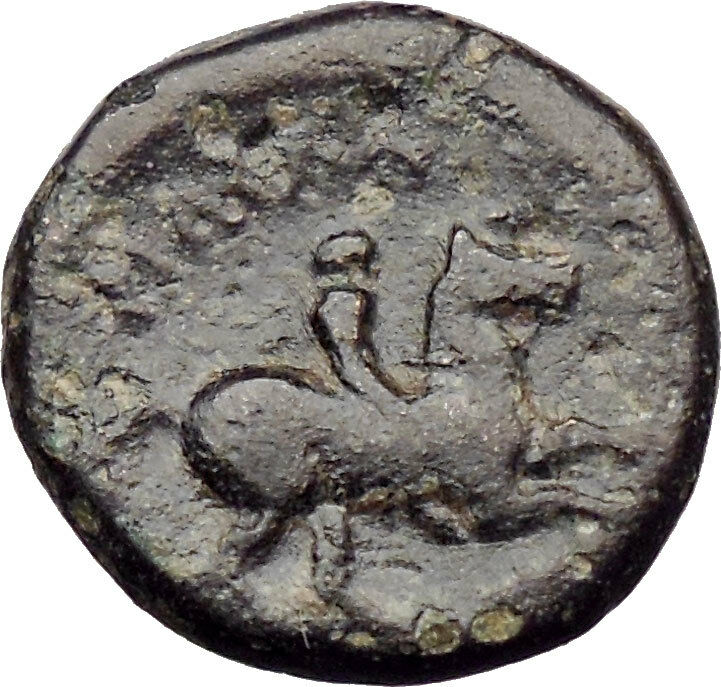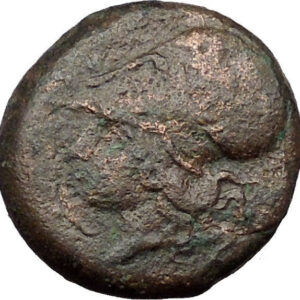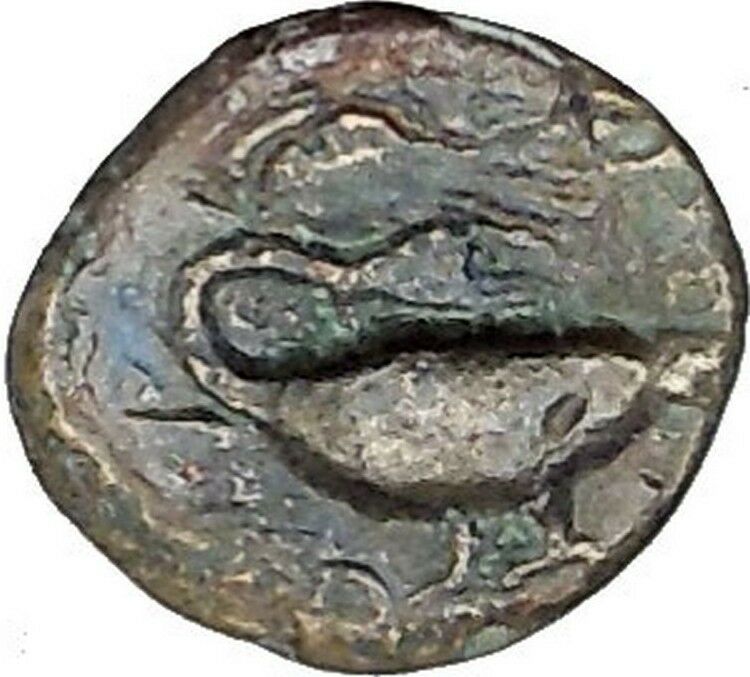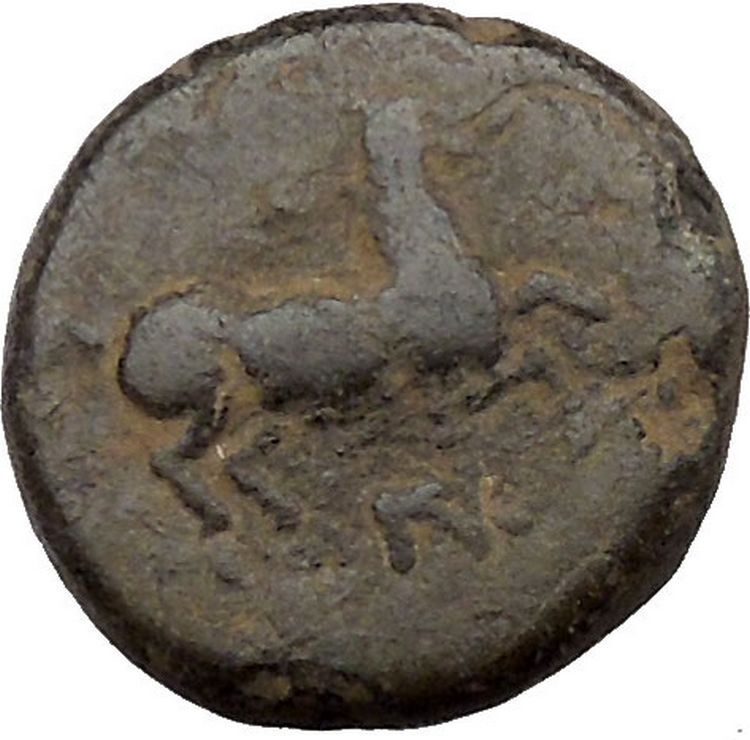|
Greek
Seleukid
Kingdom
Alexander II Zabinas
– Reigned: 128-123
B.C.
Bronze 19mm (6.91 grams) Antioch mint, struck circa 128-123 B.C.
Reference: Sear 7125; B.M.C. 4.82, 16; HGC 9, 1161; SC 2229
His diademed head right.
ΒΑΣΙΛΕΩΣ / ΑΛΕΞΑΝΔΡΟΥ either side of young Dionysos standing left, holding
kantharos
and thyrsos; in field to left, Σ and Seleucid date.
Claiming to be an adopted son of Alexander Balas, Zebina
rebelled against Demetrios II with the backing of Ptolemy VII of Egypt. Five
years later he was defeated by the forces of Cleopatra and her son Antiochos
VIII.
You are bidding on the exact item pictured,
provided with a Certificate of Authenticity and Lifetime Guarantee of
Authenticity.
Dionysus Bacchus was the
god
of the grape harvest,
winemaking
and
wine, of ritual madness and
ecstasy
in
Greek mythology
. His name in
Linear B
tablets shows he was worshipped from
c. 1500—1100 BC by
Mycenean Greeks
: other traces of Dionysian-type
cult have been found in ancient
Minoan Crete
. His origins are uncertain, and
his cults took many forms; some are described by ancient sources as Thracian,
others as Greek. In some cults, he arrives from the east, as an Asiatic
foreigner; in others, from
Ethiopia
in the South.

He
is a god of epiphany
, “the god that comes,” and his
“foreignness” as an arriving outsider-god may be inherent and essential to his
cults. He is a major, popular figure of
Greek mythology
and
religion
, and is included in some lists of the
twelve Olympians
. Dionysus was the last god to
be accepted into Mt. Olympus. He was the youngest and the only one to have a
mortal mother His festivals were the driving force behind the development of
Greek theatre
. He is an example of a
dying god
.The earliest cult images of Dionysus
show a mature male, bearded and robed. He holds a
fennel
staff, tipped with a pine-cone and known
as a thyrsus
. Later images show him as a
beardless, sensuous, naked or half-naked androgynous youth: the literature
describes him as womanly or “man-womanish.”In its fully developed form, his
central cult imagery shows his triumphant, disorderly arrival or return, as if
from some place beyond the borders of the known and civilized. His procession
(thiasus)
is made up of wild female followers (maenads)
and bearded
satyrs
with
erect penises
. Some are armed with the
thyrsus, some dance or play music. The god himself is drawn in a chariot,
usually by exotic beasts such as lions or tigers, and is sometimes attended by a
bearded, drunken Silenus
. This procession is presumed to be the
cult model for the human followers of his
Dionysian Mysteries
. In his
Thracian
mysteries, he wears the bassaris
or
fox-skin, symbolizing a new life. Dionysus is represented by city
religions as the protector of those who do not belong to conventional society
and thus symbolizes everything which is chaotic, dangerous and unexpected,
everything which escapes human reason and which can only be attributed to the
unforeseeable action of the gods.
He was also known as Bacchus, the name adopted by the
Romans
and the frenzy he induces, bakkheia.
His thyrsus is sometimes wound with ivy and dripping with honey. It is a
beneficent wand but also a weapon, and can be used to destroy those who oppose
his cult and the freedoms he represents. He is also the Liberator (Eleutherios),
whose wine, music and ecstatic dance frees his followers from self-conscious
fear and care, and subverts the oppressive restraints of the powerful. Those who
partake of his mysteries are possessed and empowered by the god himself. His
cult is also a “cult of the souls”; his maenads feed the dead through
blood-offerings, and he acts as a divine communicant between the living and the
dead.
In Greek mythology, he is presented as a son of
Zeus and the mortal
Semele
, thus semi-divine or
heroic: and as son of Zeus and
Persephone
or
Demeter
, thus both fully divine, part-chthonic
and possibly identical with
Iacchus
of the
Eleusinian Mysteries
. Some scholars believe
that Dionysus is a
syncretism
of a local Greek nature deity and a
more powerful god from
Thrace
or
Phrygia
such as
Sabazios
or
Zalmoxis
.
Names
The dio- element has been associated since antiquity with Zeus
(genitive
Dios). The earliest attested form of the name is
Mycenaean Greek
di-wo-nu-so, written in
Linear B
syllabic script,found on two tablets
at
Mycenaean
Pylos
and dated to the 12th or 13th century
BC.
Later variants include Dionūsos
and Diōnūsos in Boeotia;
Dien(n)ūsos in Thessaly;
Deonūsos and
Deunūsos in Ionia; and
Dinnūsos in Aeolia, besides
other variants. A Dio-
prefix is found in other names, such as that of the
Dioscures
, and may derive from Dios, the
genitive of the name of Zeus
.
The second element -nūsos
is associated with Mount
Nysa
, the birthplace of the god in Greek
mythology, where he was nursed by nymphs (the
Nysiads
),but according to
Pherecydes of Syros
,
nũsa was an archaic word
for “tree.”
The cult of Dionysus was closely associated with trees, specifically the
fig tree
, and some of his
bynames
exhibit this, such as
Endendros “he in the tree”
or Dendritēs, “he of the
tree.” Peters suggests the original meaning as “he who runs among the trees,” or
that of a “runner in the woods.” Janda (2010) accepts the etymology but proposes
the more cosmological interpretation of “he who impels the (world-)tree.” This
interpretation explains how Nysa could have been re-interpreted from a
meaning of “tree” to the name of a mountain: the
axis mundi
of
Indo-European mythology
is represented both as
a
world-tree
and as a
world-mountain
.
In the Greek
pantheon
, Dionysus (along with
Zeus) absorbs the role of
Sabazios
, a
Thracian
/Phrygian
deity. In the
Roman pantheon
, Sabazius became an alternate
name for Bacchus.
Mythology
Birth
Dionysus had a strange birth that evokes the difficulty in fitting him into
the
Olympian pantheon
. His mother was a mortal
woman, Semele
, the daughter of king
Cadmus
of
Thebes
, and his father was
Zeus, the king of the gods. Zeus’ wife,
Hera, discovered the affair while Semele was pregnant. Appearing as
an old crone
(in other stories a nurse), Hera
befriended Semele, who confided in her that Zeus was the actual father of the
baby in her womb. Hera pretended not to believe her, and planted seeds of doubt
in Semele’s mind. Curious, Semele demanded of Zeus that he reveal himself in all
his glory as proof of his godhood.
Though Zeus begged her not to ask this, she persisted and he agreed.
Therefore he came to her wreathed in bolts of lightning; mortals, however, could
not look upon an undisguised god without dying, and she perished in the ensuing
blaze. Zeus rescued the fetal Dionysus by sewing him into his thigh. A few
months later, Dionysus was born on Mount Pramnos in the island of
Ikaria
, where Zeus went to release the
now-fully-grown baby from his thigh. In this version, Dionysus is born by two
“mothers” (Semele and Zeus) before his birth, hence the epithet dimētōr
(of two mothers) associated with his being “twice-born.”
In the Cretan version of the same story, which
Diodorus Siculus
follows, Dionysus was the son
of Zeus and Persephone
, the queen of the
Greek underworld
. Diodorus’ sources equivocally
identified the mother as Demeter. A jealous Hera again attempted to kill the
child, this time by sending
Titans
to rip Dionysus to pieces after luring
the baby with toys. It is said that he was mocked by the Titans who gave him a
thyrsus (a fennel stalk) in place of his rightful sceptre.Zeus turned the Titans
into dust with his thunderbolts, but only after the Titans ate everything but
the heart, which was saved, variously, by
Athena
,
Rhea
, or
Demeter
. Zeus used the heart to recreate him in
his thigh
, hence he was again “the twice-born.”
Other versions claim that Zeus recreated him in the womb of Semele, or gave
Semele the heart to eat to impregnate her.
The rebirth in both versions of the story is the primary reason why Dionysus
was worshipped in
mystery religions
, as his death and rebirth
were events of mystical reverence. This narrative was apparently used in several
Greek and Roman cults, and variants of it are found in
Callimachus
and
Nonnus
, who refer to this Dionysus with the
title Zagreus
, and also in several fragmentary poems
attributed to Orpheus
.
The myth of the dismemberment of Dionysus by the Titans, is alluded to by
Plato
in his
Phaedo
(69d) in which Socrates claims that the
initiations of the Dionysian Mysteries are similar to those of the philosophic
path. Late Neo-Platonists such as
Damascius
explore the implications of this at
length.
Infancy at Mount Nysa
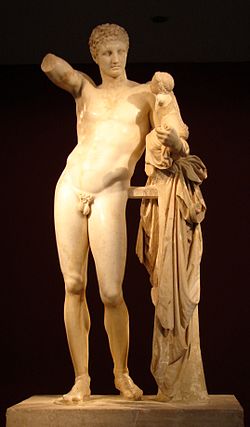
Hermes and the Infant Dionysus
by
Praxiteles
, (Archaeological
Museum of Olympia).
According to the myth Zeus gave the infant Dionysus into the charge of
Hermes
. One version of the story is that Hermes
took the boy to King
Athamas
and his wife
Ino
, Dionysus’ aunt. Hermes bade the couple
raise the boy as a girl, to hide him from Hera’s wrath.[39]
Another version is that Dionysus was taken to the rain-nymphs
of
Nysa
, who nourished his infancy and childhood,
and for their care Zeus rewarded them by placing them as the
Hyades
among the stars (see
Hyades star cluster
). Other versions have Zeus
giving him to Rhea, or to Persephone to raise in the Underworld, away from Hera.
Alternatively, he was raised by
Maro
.
Dionysus in Greek mythology is a god of foreign origin, and while Mount Nysa
is a mythological location, it is invariably set far away to the east or to the
south. The
Homeric hymn
to Dionysus places it “far from
Phoenicia, near to the Egyptian stream.” Others placed it in Anatolia, or in
Libya
(‘away in the west beside a great
ocean’), in Ethiopia (Herodotus), or
Arabia
(Diodorus Siculus).
According to
Herodotus
:
As it is, the Greek story has it that no sooner was Dionysus born than
Zeus sewed him up in his thigh and carried him away to
Nysa
in Ethiopia beyond
Egypt
; and as for
Pan
, the Greeks do not know what became
of him after his birth. It is therefore plain to me that the Greeks
learned the names of these two gods later than the names of all the
others, and trace the birth of both to the time when they gained the
knowledge.
—Herodotus, Histories 2.146
The
Bibliotheca
seems to be following
Pherecydes, who relates how the infant Dionysus, god of the grapevine, was
nursed by the rain-nymphs, the
Hyades
at Nysa.
Childhood
When Dionysus grew up, he discovered the culture of the vine and the mode of
extracting its precious juice; but Hera struck him with madness, and drove him
forth a wanderer through various parts of the earth. In
Phrygia
the goddess
Cybele
, better known to the Greeks as Rhea,
cured him and taught him her religious rites, and he set out on a progress
through Asia teaching the people the cultivation of the vine. The most famous
part of his wanderings is his expedition to
India
, which is said to have lasted several
years. Returning in triumph he undertook to introduce his worship into Greece,
but was opposed by some princes who dreaded its introduction on account of the
disorders and madness it brought with it (e.g.
Pentheus
or
Lycurgus
).

North African Roman mosaic: Panther-Dionysus scatters the pirates,
who are changed to dolphins, except for
Acoetes
, the helmsman. (Bardo
National Museum)
Dionysus was exceptionally attractive. One of the
Homeric hymns
recounts how, while disguised as
a mortal sitting beside the seashore, a few sailors spotted him, believing he
was a prince. They attempted to kidnap him and sail him far away to sell for
ransom or into slavery. They tried to bind him with ropes, but no type of rope
could hold him. Dionysus turned into a fierce lion and unleashed a bear on
board, killing those he came into contact with. Those who jumped off the ship
were mercifully turned into dolphins. The only survivor was the helmsman,
Acoetes
, who recognized the god and tried to
stop his sailors from the start.
In a similar story, Dionysus desired to sail from
Icaria
to
Naxos
. He then hired a
Tyrrhenian
pirate ship. However, when the god
was on board, they sailed not to Naxos but to Asia, intending to sell him as a
slave. So Dionysus turned the mast and oars into snakes, and filled the vessel
with ivy and the sound of flutes so that the sailors went mad and, leaping into
the sea, were turned into dolphins.
Other stories
Midas
Once, Dionysus found his old school master and foster father,
Silenus
, missing. The old man had been
drinking, and had wandered away drunk, and was found by some peasants, who
carried him to their king (alternatively, he passed out in Midas’ rose garden).
Midas
recognized him, and treated him
hospitably, entertaining him for ten days and nights with politeness, while
Silenus entertained Midas and his friends with stories and songs. On the
eleventh day, he brought Silenus back to Dionysus. Dionysus offered Midas his
choice of whatever reward he wanted.
Midas asked that whatever he might touch should be changed into gold.
Dionysus consented, though was sorry that he had not made a better choice. Midas
rejoiced in his new power, which he hastened to put to the test. He touched and
turned to gold an oak twig and a stone. Overjoyed, as soon as he got home, he
ordered the servants to set a feast on the table. Then he found that his bread,
meat, daughter and wine turned to gold.
Upset, Midas strove to divest himself of his power (the
Midas Touch
); he hated the gift he had coveted.
He prayed to Dionysus, begging to be delivered from starvation. Dionysus heard
and consented; he told Midas to wash in the river
Pactolus
. He did so, and when he touched the
waters the power passed into them, and the river sands changed into gold. This
was an
etiological myth
that explained why the sands
of the Pactolus were rich in gold.
Pentheus
Euripides
composed a tragedy about the
destructive nature of Dionysus in
The Bacchae
. Since Euripides wrote this
play while in the court of King
Archelaus
of
Macedon
, some scholars believe that the cult of
Dionysus was malicious in Macedon but benign in
Athens
.
In the play, Dionysus returns to his birthplace,
Thebes
, which is ruled by his cousin
Pentheus
. Dionysus wants to exact revenge on
Pentheus and the women of Thebes (his aunts
Agave
,
Ino
and
Autonoe
) for not believing his mother Semele’s
claims of being impregnated by Zeus, and for denying Dionysus’s divinity (and
therefore not worshiping him).
Dionysus slowly drives Pentheus mad, lures him to the woods of
Mount Cithaeron
, and then convinces him to
spy/peek on the
Maenads
(female worshippers of Dionysus, who
often experienced divine ecstasy). The Maenads are in an insane frenzy when
Pentheus sees them (earlier in the play they had ripped apart a herd of cattle),
and they catch him but mistake him for a wild animal. Pentheus is torn to
shreds, and his mother (Agave, one of the Maenads), not recognizing her own son
because of her madness, brutally tears his limbs off as he begs for his life.
As a result of their acts the women are banished from Thebes, ensuring
Dionysus’s revenge.
Lycurgus
When King
Lycurgus
of
Thrace
heard that Dionysus was in his kingdom,
he imprisoned all the followers[Maenads] of Dionysus; the god fled, taking
refuge with Thetis
, and sent a drought which stirred the
people into revolt. Dionysus then made King Lycurgus insane, having him slice
his own son into pieces with an axe, thinking he was a patch of ivy, a plant
holy to Dionysus. An
oracle
then claimed that the land would stay
dry and barren as long as Lycurgus was alive, so his people had him
drawn and quartered
; with Lycurgus dead,
Dionysus lifted the curse. This story was told in Homer’s epic, Iliad
6.136-7. In an alternative version, sometimes shown in art, Lycurgus tried to
kill Ambrosia, a follower of Dionysus, who was transformed into a vine that
twined around the enraged king and restrained him, eventually killing him.
Prosymnus
A better-known story is that of his descent to Hades to rescue his mother
Semele, whom he placed among the stars. Dionysus feared for his mother, whom he
had not seen since birth. He bypassed the god of death, known as Thanatos, thus
successfully returning Semele to Mount Olympus. Out of the twelve Olympians, he
was of the few that could restore the deceased from the underworld back to life.
He made the descent from a reputedly bottomless pool on the coast of the
Argolid
near the prehistoric site of
Lerna
. He was guided by
Prosymnus
or Polymnus, who requested, as his
reward, to be Dionysus’ lover. Prosymnus died before Dionysus could honor his
pledge, so in order to satisfy Prosymnus’ shade, Dionysus fashioned a
phallus
from an olive branch and sat on it at
Prosymnus’ tomb.This story survives in full only in Christian sources whose aim
was to discredit pagan mythology. It appears to have served as an explanation of
the secret objects that were revealed in the
Dionysian Mysteries
.
Ampelos
Another myth according to
Nonnus
involves
Ampelos
, a
satyr
, who was loved by Dionysus.Foreseen by
Dionysus, the youth was killed in an accident riding a bull maddened by the
sting of an Ate
‘s gadfly. The
Fates
granted Ampelos a second life as a vine,
from which Dionysus squeezed the first wine.
Chiron
Young Dionysus was also said to have been one of the many famous pupils of
the centaur
Chiron
. According to Ptolemy Chennus in the
Library of Photius, “Dionysius was loved by Chiron, from whom he learned chants
and dances, the bacchic rites and initiations.”
Secondary myths
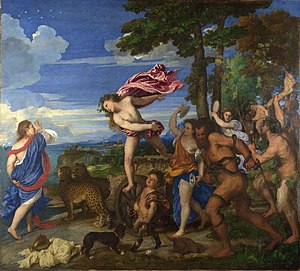
Bacchus and Ariadne
by
Titian
, at the
National Gallery
in London.
When Hephaestus
bound
Hera to a magical chair, Dionysus got him drunk and brought him back
to Olympus after he passed out.
A third descent by Dionysus to Hades is invented by
Aristophanes
in his comedy
The Frogs
. Dionysus, as patron of the
Athenian dramatic festival, the Dionysia, wants to bring back to life one
of the great tragedians. After a competition
Aeschylus
is chosen in preference to
Euripides
.
When Theseus
abandoned
Ariadne
sleeping on Naxos, Dionysus found and
married her. She bore him a son named Oenopion, but he committed suicide or was
killed by Perseus
. In some variants, he had her crown put
into the heavens as the constellation Corona; in others, he descended into
Hades
to restore her to the gods on Olympus.
Another different account claims Dionysus ordered Theseus to abandon Ariadne on
the island of Naxos for he had seen her as Theseus carried her onto the ship and
had decided to marry her.
Psalacantha
, a nymph, failed at winning the
love of Dionysus as his main love interest at the moment was Ariadne, and ended
up being changed into a plant.
Callirrhoe was a
Calydonian
woman who scorned
Coresus
, a priest of Dionysus, who threatened
to afflict all the women of Calydon with insanity (see
Maenad
). The priest was ordered to sacrifice
Callirhoe but he killed himself instead. Callirhoe threw herself into a well
which was later named after her.
Acis
, a
Sicilian
youth, was sometimes said to be
Dionysus’ son.
Alexander II Zabinas, ruler of the
Greek
Seleucid kingdom
, was a counter-king who emerged in the chaos following the
Seleucidian
loss of
Mesopotamia
to the
Parthians
.
Zabinas was a false Seleucid who claimed to be an adoptive son of
Antiochus VII Sidetes
, but in fact seems to have been the son of an Egyptian
merchant named Protarchus.
Antioch
,
Apamea
, and
several other cities, disgusted with the tyranny of Demetrius, acknowledged the
authority of Alexander. He was used as a pawn by the
Egyptian
king
Ptolemy VIII Tryphon
, who introduced Zabinas as a means of getting to the
legitimate Seleucid king
Demetrius II
, who supported his sister
Cleopatra II
against him in the complicated dynastic feuds of the latter
Hellenistic dynasties.
Zabinas managed to defeat Demetrius II, who fled to
Tyre
and was killed there, and thereafter ruled parts of
Syria
(128 BC-123
BC), but soon ran out of Egyptian support and was in his turn was defeated by
Demetrius’ son
Antiochus VIII Grypus
.
Zabinas fled to the Seleucid capital
Antiochia
,
where he plundered several temples. He is said to have joked about melting down
a statuette of the goddess of victory
Nike
which was held in the hand of a
Zeus statue, saying
“Zeus has given me Victory”. Enraged by his impiety the Antiochenes cast Zabinas
out of the city. He soon fell into the hands of robbers, who delivered him up to
Antiochus, by whom he was put to death, in 122 BC.
The name “Zabinas” means “the purchased slave”, and was applied to him,
deprecatingly, in response to a report that he had been bought by Ptolemy as a
slave. For reasons unknown, Alexander II was the only late Seleucid not to use
epithets on his coins. Several of his coins are extant.
Preceded byy
Antiochus VII Sidetes
|
Seleucid King
128–123 BC |
Succeeded by
Antiochus VIII Grypus
and
Cleopatra Thea
|
The Seleucid
Empire was a
Greek
–Macedonian
state that was created out of the eastern conquests
of
Alexander the
Great
At the height of its power, it included central
Anatolia
,
the
Levant
,
Mesopotamia
,
Persia
,
today’s
Turkmenistan
,
Pamir
and parts of
Pakistan
.

Seleucus I
Nicator
,
the founder of the Seleucid Empire.
The Seleucid Empire
was a major center of
Hellenistic culture
which maintained the preeminence of
Greek
customs and where a
Greek
–Macedonian
political elite dominated, mostly in the urban areas.
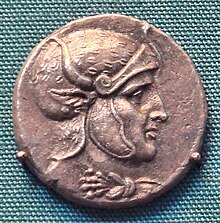
Coin of
Seleucus I Nicator
The
Greek
population of the cities who formed the dominant elite were reinforced by
emigration from
Greece
.
Seleucid expansion into Egypt was abruptly halted after decisive defeats at the
hands of the
Roman army
.
Much of the eastern part of the empire was conquered by the
Parthians
under
Mithridates I of
Parthia
in the mid-2nd century BC, yet the Seleucid kings continued to rule a
rump state
from Syria
until the invasion by
Armenian
king
Tigranes the Great
and their ultimate overthrow by the
Roman
general
Pompey
.
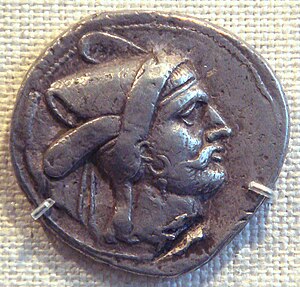
Bagadates I
(Minted 290–280 BC) was the first indigenous Seleucid satrap to be appointed
Partition of
Alexander’s empire
Alexander
conquered the
Persian Empire
under its last Achaemenid dynast,
Darius III
,
within a short time-frame and died young, leaving an expansive empire of partly
Hellenised culture without an adult heir. The empire was put under the authority
of a regent in the person of
Perdiccas
in 323 BC, and the territories were divided between Alexander’s generals, who
thereby became
satraps
,
at the
Partition of Babylon
in 323 BC.
Rise of Seleucus
Alexander’s
generals (the
Diadochi
)
jostled for supremacy over parts of his empire.
Ptolemy
,
a former general and the satrap of
Egypt
,
was the first to challenge the new system; this led to the demise of Perdiccas.
Ptolemy’s revolt led to a new subdivision of the empire with the
Partition of
Triparadisus
in 320 BC.
Seleucus
,
who had been “Commander-in-Chief of the camp” under Perdiccas since 323 BC but
helped to assassinate him later, received
Babylonia
,
and from that point continued to expand his dominions ruthlessly. Seleucus
established himself in
Babylon
in 312 BC, the year used as the foundation date of the Seleucid Empire. He ruled
not only Babylonia, but the entire enormous eastern part of Alexander’s empire:
“Always lying
in wait for the neighboring nations, strong in arms and persuasive in
council, he [Seleucus] acquired Mesopotamia, Armenia, ‘Seleucid’
Cappadocia, Persis, Parthia, Bactria, Arabia, Tapouria, Sogdia,
Arachosia, Hyrcania, and other adjacent peoples that had been subdued by
Alexander, as far as the river Indus, so that the boundaries of his
empire were the most extensive in Asia after that of Alexander. The
whole region from Phrygia to the Indus was subject to Seleucus.”
—
Appian
, The
Syrian Wars
Seleucus
went as far as
India
,
where after
two years of war
he reached an agreement with
Chandragupta Maurya
,
in which he exchanged his eastern territories for a considerable force of 500
war elephants
,
which would play a decisive role at
Ipsus
(301 BC).
“The Indians
occupy [in part] some of the countries situated along the Indus, which
formerly belonged to the Persians: Alexander deprived the Ariani of
them, and established there settlements of his own. But
Seleucus
Nicator
gave them to
Sandrocottus
in consequence of a marriage contract, and received in return five
hundred elephants.”
Westward expansion
Following his and
Lysimachus
‘
victory over
Antigonus
Monophthalmus
at the decisive
Battle of Ipsus
in 301 BC, Seleucus took control over eastern
Anatolia
and northern
Syria
.
In the latter area
he founded a new capital at
Antioch on the Orontes
,
a city he named after his father. An alternative capital was established at
Seleucia on the Tigris
,
north of Babylon. Seleucus’ empire reached its greatest extent following his
defeat of his erstwhile ally, Lysimachus, at
Corupedion
in 281 BC, after which Seleucus expanded his control to encompass western
Anatolia. He hoped further to take control of Lysimachus’ lands in Europe –
primarily
Thrace
and even
Macedonia
itself, but was assassinated by
Ptolemy Ceraunus
on landing in Europe.
His son and
successor,
Antiochus I Soter
,
was left with an enormous realm consisting of nearly all of the Asian portions
of the Empire, but faced with
Antigonus II Gonatas
in Macedonia and
Ptolemy II
Philadelphus
in Egypt
,
he proved unable to pick up where his father had left off in conquering the
European portions of Alexander’s empire.
An overextended domain
Nevertheless, even
before Seleucus’ death, it was difficult to assert control over the vast eastern
domains of the Seleucids. Seleucus invaded
India
(modern
Punjab
Pakistan
)
in 305 BC,
confronting
Chandragupta Maurya
(Sandrokottos),
founder of the
Maurya empire
.
It is said that Chandragupta fielded an army of 600,000 men and 9,000 war
elephants (Pliny, Natural History VI, 22.4).
Mainstream
scholarship asserts that Chandragupta received vast territory, sealed in a
treaty, west of the Indus, including the
Hindu Kush
,
modern day
Afghanistan
,
and the
Balochistan
province of
Pakistan
.[11][12]
Archaeologically, concrete indications of Mauryan rule, such as the inscriptions
of the
Edicts of Ashoka
,
are known as far as
Kandahar
in southern Afghanistan.
|
“ |
“He (Seleucus) crossed the Indus and waged war with Sandrocottus
[Maurya], king of the Indians, who dwelt on the banks of that stream,
until they came to an understanding with each other and contracted a
marriage relationship.” |
” |
It is generally
thought that Chandragupta married
Seleucus’s
daughter, or a
Macedonian
princess
,
a gift from Seleucus to formalize an alliance. In a return gesture, Chandragupta
sent 500 war
–elephants,[13][14][15][16][17]
a military asset which would play a decisive role at the
Battle of Ipsus
in 301 BC. In addition to this treaty, Seleucus dispatched an ambassador,
Megasthenes
,
to Chandragupta, and later
Deimakos
to his son
Bindusara
,
at the Mauryan court at
Pataliputra
(modern
Patna
in
Bihar state
).
Megasthenes wrote detailed descriptions of India and Chandragupta’s reign, which
have been partly preserved to us through
Diodorus Siculus
.
Later
Ptolemy II
Philadelphus
,
the ruler of
Ptolemaic Egypt
and contemporary of
Ashoka the Great
,
is also recorded by
Pliny the Elder
as having sent an ambassador named
Dionysius
to the Mauryan court.[18]
Other territories
lost before Seleucus’ death were
Gedrosia
in the south-east of the Iranian plateau, and, to the north of this,
Arachosia
on the west bank of the
Indus River
.
Antiochus I
(reigned 281–261 BC) and his son and successor
Antiochus II Theos
(reigned 261–246 BC) were faced with challenges in the west, including repeated
wars with
Ptolemy II
and a
Celtic
invasion of Asia Minor — distracting attention from holding the eastern portions
of the Empire together. Towards the end of Antiochus II’s reign, various
provinces simultaneously asserted their independence, such as
Bactria
under
Diodotus
,
Parthia
under
Arsaces
,
and
Cappadocia
under
Ariarathes III
.
Diodotus
,
governor for the
Bactrian
territory, asserted independence in around 245 BC, although the exact date is
far from certain, to form the
Greco-Bactrian
kingdom. This kingdom was characterized by a rich
Hellenistic
culture, and was to continue its domination of Bactria until around 125 BC, when
it was overrun by the invasion of northern nomads. One of the Greco-Bactrian
kings,
Demetrius I of Bactria
,
invaded India around 180 BC to form the
Greco-Indian
kingdom, lasting until around AD 20.
The Seleucid satrap
of Parthia, named
Andragoras
,
first claimed independence, in a parallel to the secession of his Bactrian
neighbour. Soon after however, a Parthian tribal chief called
Arsaces
invaded the Parthian
territory around 238 BC to form the
Arsacid Dynasty
— the starting point of the powerful
Parthian Empire
.
By the time
Antiochus II’s son
Seleucus II Callinicus
came to the throne around 246 BC, the Seleucids seemed to be at a low ebb
indeed. Seleucus II was soon dramatically defeated in the
Third Syrian War
against
Ptolemy III of Egypt
and then had to fight a civil war against his own brother
Antiochus Hierax
.
Taking advantage of this distraction, Bactria and Parthia seceded from the
empire. In Asia Minor too, the Seleucid dynasty seemed to be losing control —
Gauls had fully established themselves in
Galatia
,
semi-independent semi-Hellenized kingdoms had sprung up in
Bithynia
,
Pontus
,
and
Cappadocia
,
and the city of
Pergamum
in the west was asserting its independence under the
Attalid Dynasty
.
Revival (223–191
BC)
A revival would
begin when Seleucus II’s younger son,
Antiochus III the
Great
,
took the throne in 223 BC. Although initially unsuccessful in the
Fourth Syrian War
against Egypt, which led to a defeat at the
Battle of Raphia
(217 BC), Antiochus would prove himself to be the greatest of the Seleucid
rulers after Seleucus I himself. He spent the next ten years on his
anabasis
through the eastern parts of his domain and restoring rebellious vassals like
Parthia and
Greco-Bactria
to at least nominal obedience. He won the
Battle of the Arius
and
besieged the Bactrian
capital
,
and even emulated Alexander with an expedition into India where he met with king
Sophagasenus
receiving war elephants:
“He (Antiochus)
crossed the Caucasus and descended into India; renewed his friendship with
Sophagasenus the king of the Indians; received more elephants, until he had
a hundred and fifty altogether; and having once more provisioned his troops,
set out again personally with his army: leaving Androsthenes of Cyzicus the
duty of taking home the treasure which this king had agreed to hand over to
him”. Polybius 11.39
When he returned to
the west in 205 BC, Antiochus found that with the death of
Ptolemy IV
,
the situation now looked propitious for another western campaign. Antiochus and
Philip V of Macedon
then made a pact to divide the Ptolemaic possessions outside of Egypt, and in
the
Fifth Syrian War
,
the Seleucids ousted
Ptolemy V
from control of
Coele-Syria
.
The
Battle of Panium
(198 BC) definitively transferred these holdings from the Ptolemies to the
Seleucids. Antiochus appeared, at the least, to have restored the Seleucid
Kingdom to glory.
Expansion
into Greece and War with Rome
Following his
erstwhile ally
Philip’s
defeat by Rome in 197 BC, Antiochus saw the opportunity for expansion into
Greece itself. Encouraged by the exiled
Carthaginian
general
Hannibal
,
and making an alliance with the disgruntled
Aetolian League
,
Antiochus launched an invasion across the
Hellespont
.
With his huge army he was intent upon establishing the Seleucid empire as the
foremost power in the Hellenic world but these plans put the empire on a
collision course with the new superpower of the Mediterranean, the
Roman Republic
.
At the battles of
Thermopylae
and
Magnesia
,
Antiochus’s forces were resoundingly defeated and he was compelled to make peace
and sign the
Treaty of Apamea
in (188 BC), the main clause of which saw the Seleucids agree to pay a large
indemnity, retreat from
Anatolia
and to never again attempt to expand Seleucid territory west of the
Taurus Mountains
.
The
Kingdom of Pergamum
and the
Republic of Rhodes
,
Rome’s allies in the war, were given the former Seleucid lands in Anatolia.
Antiochus died in 187 BC on another expedition to the east, where he sought to
extract money to pay the indemnity.
Roman power,
Parthia and Judea
The reign of his
son and successor
Seleucus IV Philopator
(187-175 BC) was largely spent in attempts to pay the large indemnity, and
Seleucus was ultimately assassinated by his minister
Heliodorus
.
Seleucus’ younger brother,
Antiochus IV Epiphanes
,
now seized the throne. He attempted to restore Seleucid power and prestige with
a successful war against the old enemy,
Ptolemaic Egypt
,
which met with initial success as the Seleucids defeated and drove the Egyptian
army back to
Alexandria
itself. As the king planned on how to conclude the war, he was informed that
Roman commissioners, led by the
Proconsul
Gaius Popillius Laenas
,
were near and requesting a meeting with the Seleucid king. Antiochus agreed, but
when they met and Antiochos held out his hand in friendship, Popilius placed in
his hand the tablets on which was written the decree of the senate and telling
him to read it. When the king said that he would call his friends into council
and consider what he ought to do, Popilius drew a circle in the sand around the
king’s feet with the stick he was carrying and said, “Before you step out of
that circle give me a reply to lay before the senate.” For a few moments he
hesitated, astounded at such a peremptory order, and at last replied, “I will do
what the senate thinks right.” He then chose to withdraw rather than set the
empire to war with Rome again.
The latter part of
his reign saw a further disintegration of the Empire despite his best efforts.
Weakened economically, militarily and by loss of prestige, the Empire became
vulnerable to rebels in the eastern areas of the empire, who began to further
undermine the empire while the Parthians moved into the power vacuum to take
over the old Persian lands. Antiochus’ aggressive Hellenizing (or de-Judaizing)
activities provoked a full scale armed rebellion in
Judea
—the
Maccabean Revolt
.
Efforts to deal with both the Parthians and the Jews as well as retain control
of the provinces at the same time proved beyond the weakened empire’s power.
Antiochus died during a military expedition against the Parthians in 164 BC.
|













